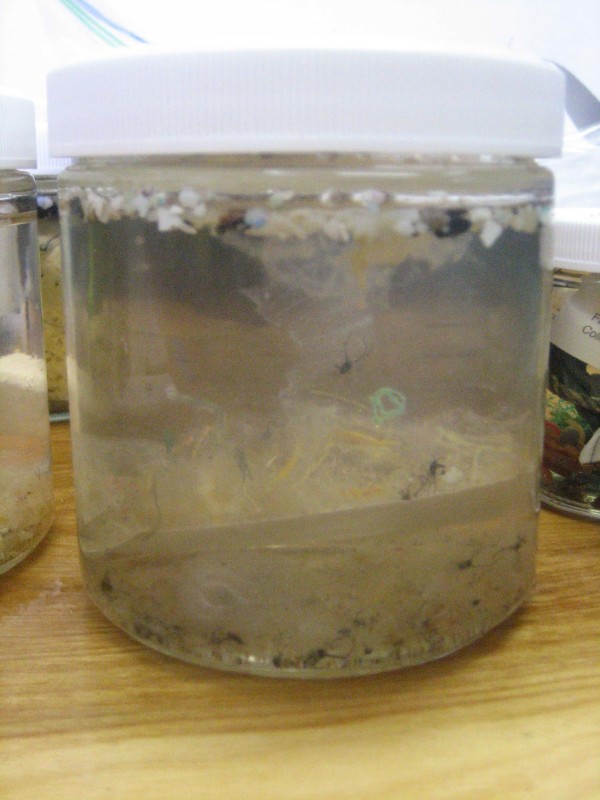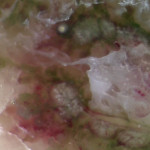As some of you may know, my graduate research is on plastic debris in the North Pacific Central Gyre. While I am deeply disturbed by the incredible amounts of plastic permeating our oceans, I also feel that taking a critical, scientific look at this issue is key to finding a solution. Misinformation on this issue is rampant – for example, I’ve waged a personal war against this image, which is neither trash nor a gyre.
Which brings me to “Recycled Island.” A Dutch architecture company has proposed to take all the plastic floating in the North Pacific Central Gyre and mold it into a vast island. I first became aware of this when renderings were published on Inhabitat in April, but it has come to the forefront again with articles in io9 and the Guardian, and a post in Metafilter. (Tip of the antennae to Adam E. & Jonathan Gitlin. Ed: Also Ethan!)
According to the Guardian article:
Recycled Island is a plan to clean up 44 million kilos of plastic waste from the North Pacific Gyre, which stretches from California to Japan, and provide 10,000 square kilometres (3,861 square miles) of sustainable living space in the process. Solar and wave energy would provide power for islanders while sustainable fishing and agriculture could provide their food.
Great! No longer will I need expensive oceanographic cruises to study the open sea! On Recycled Island, I’ll be able to catch exotic open-ocean invertebrates from the comfort of my own recycled porch! But of course, there are a number of issues with this rather romantic plan. And as your friendly neighborhood ocean blogger (who did lead an expedition to measure plastic in the gyre last summer), it is my duty to crush my own hopes and dreams of completing my graduate studies on a luxurious and environmentally correct island, sipping tropical drinks adorned with tiny recycled umbrellas.
The main problem is this: The vast majority of plastic bits (>90%) are smaller than a pencil eraser, and are spread out enough to be mostly invisible to the naked eye. It is therefore extremely hard to remove the plastic without catching a lot of ocean life.
Please allow me to quote myself, from the SEAPLEX FAQ:
The vast majority of the debris is tiny, hard-to-see pieces. The debris is like a thin soup, with some big pieces like nets and bottles intermixed. It looks like this.
We did not observe an island or floating landfill. Our photos are representative of what we saw – larger pieces floating by every minute or so, with the space between filled up with tiny, nearly microscopic bits.
This means that these pieces are the same size as much of the zooplankton. In fact, most of the organizations who have been out to the gyre to measure plastic have used fine-meshed nets (333 microns, for the most part) that are designed to catch zooplankton. When a swimming-pool sized bit of ocean is concentrated into a jar, you get a bunch of little plastic bits, but you also get a bunch of zooplankton. Here’s an example from the SEAPLEX cruise last year:

The “Recycled Island” folks may be able to build a giant island out of recycled plastic – I am not an architect and I have no idea if this is feasible. (Though I hope they know that there are hurricanes in Central Pacific…) But I do know that it would be very, very difficult to remove a significant percentage of the plastic without catching a ton of zooplankton. And catching and killing tons of marine life would not be a good way to meet the criteria of the project. From the Guardian article:
Recycled Island could be a unique opportunity to save marine life. “The project should be carried out with great care so no negative influence to the environment is made,” states the project’s website. “Our ideal is to return more balance to the environment and set an example of how an environment-friendly habitat could be created.”
I could say a lot more about how little is known about the impacts of plastic in the North Pacific Central Gyre, or about the ridiculous notion that adding a giant land mass would “return more balance” to the open ocean – but I’ve got to sleep sometime. So to summarize, I do not think Recycled Island is feasible because it would be environmentally damaging to collect enough plastic in the North Pacific Central Gyre to build their enormous island.
[cross-posted to the SEAPLEX blog]





Excellent write-up Miriam. The whole recycled island idea seems less than half-baked.
Those images from the SEAPLEX expedition are just amazing. I don’t think I could have ever gotten any actual work done if I’d have been there – I wouldn’t have been able to stop putting all those little critters under microscopes and cameras for hours on end.
This is a useful article. I’m always looking for smart resources to show my coworkers, and your article is without a doubt worth sharing!
That’s why I love working with zooplankton – I never get tired of seeing what comes up in the net. The blue amphipods (Lycaea pulex) from SEAPLEX might be my favorite tow ever, though – absolutely stunning.
Great post, Miriam! Also, those amphipods ARE really stunning.
This is a great post. Granting the recycled Island is a possibility, I hope this is not just intended to lure away the world from the serious problem of plastic waste generation. It looks like it is simply made to tell the world to produce and use more plastics, anyways, will just turn them into recycled islands.Its just a pro-plastic propaganda.
It occurred to me (no scientist)that perhaps this giant area of pollution in the Pacific, just might be influencing El Nino. Logically the sun shinning on this volume of plastic must warm the sea, as per the sun shinning through a perspex conservatory.
Or am I totally wrong? One thing is for sure, the world wide plastics industry should be made to finance a large share of the cost of clean up; it is also for sure that, that industry has a very large investment in the area of lobbyist’s, which is why Global Warming does not deal with the real question of Global Pollution, the bulk of which is plastic.
If the zooplankton settles to the bottom of the sample while the plastic floats in the top of the sample in the above pic, then a scientific process of skimming plastic while simultaneously returning the zooplankton back into the ocean should be an easier technology to develop right? After all it practically separates itself! I think it is a novel idea and warrants everyones attention to finding the solution for this amount of pollution residing in our oceans. Apathy does nothing.
The zooplankton in that sample has sunk because they’re dead. In life, they were actively swimming in the same place as the plastic – that entire sample is from skimming the top 20 cm of the ocean surface.
Miriam,
Why could we not somehow grow the needed zooplankton (in an controlled environment) to be added back into the oceans steadily following a sifting process?
We are not able to grow most ocean zooplankton in the lab – it’s hard to keep most zooplankton alive long enough to study them (say, 24 hours) and nearly impossible to make them reproduce. In fact, we’re not able to grow MOST living things in captivity, from fish to bacteria. The species you see in captivity are a teeny tiny fraction of the species in the world. The ocean is super complicated and we don’t really understand it. For that reason, it’s important to do our best to not mess it up in the first place.